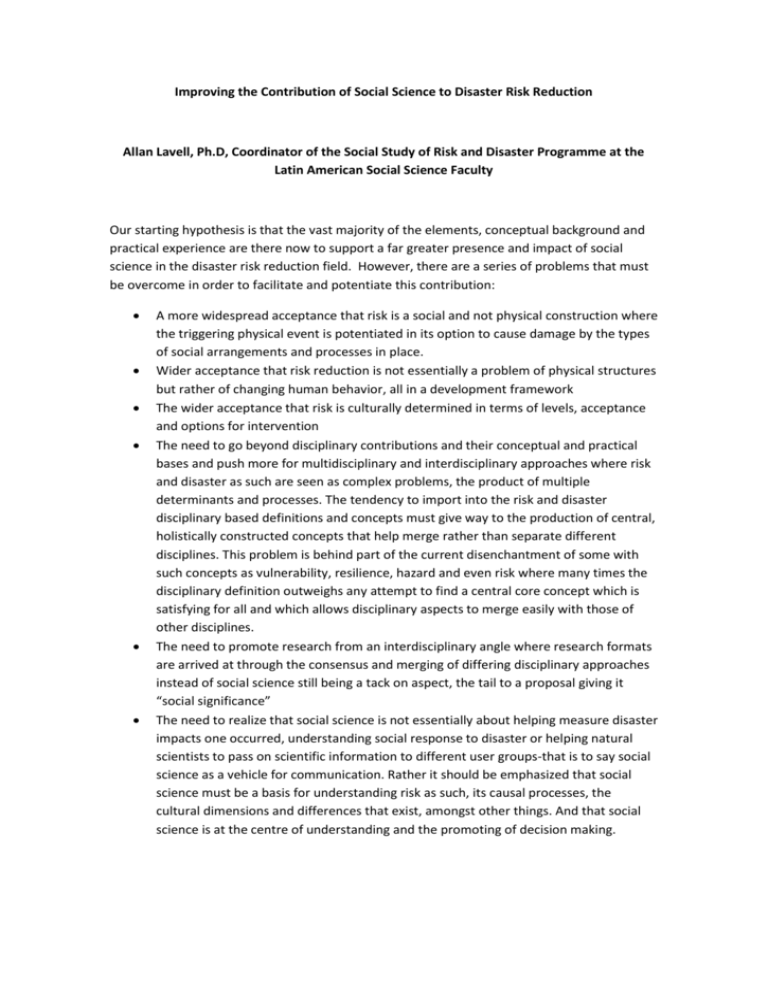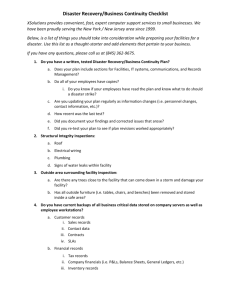Allan Lavell - PreventionWeb
advertisement

Improving the Contribution of Social Science to Disaster Risk Reduction Allan Lavell, Ph.D, Coordinator of the Social Study of Risk and Disaster Programme at the Latin American Social Science Faculty Our starting hypothesis is that the vast majority of the elements, conceptual background and practical experience are there now to support a far greater presence and impact of social science in the disaster risk reduction field. However, there are a series of problems that must be overcome in order to facilitate and potentiate this contribution: A more widespread acceptance that risk is a social and not physical construction where the triggering physical event is potentiated in its option to cause damage by the types of social arrangements and processes in place. Wider acceptance that risk reduction is not essentially a problem of physical structures but rather of changing human behavior, all in a development framework The wider acceptance that risk is culturally determined in terms of levels, acceptance and options for intervention The need to go beyond disciplinary contributions and their conceptual and practical bases and push more for multidisciplinary and interdisciplinary approaches where risk and disaster as such are seen as complex problems, the product of multiple determinants and processes. The tendency to import into the risk and disaster disciplinary based definitions and concepts must give way to the production of central, holistically constructed concepts that help merge rather than separate different disciplines. This problem is behind part of the current disenchantment of some with such concepts as vulnerability, resilience, hazard and even risk where many times the disciplinary definition outweighs any attempt to find a central core concept which is satisfying for all and which allows disciplinary aspects to merge easily with those of other disciplines. The need to promote research from an interdisciplinary angle where research formats are arrived at through the consensus and merging of differing disciplinary approaches instead of social science still being a tack on aspect, the tail to a proposal giving it “social significance” The need to realize that social science is not essentially about helping measure disaster impacts one occurred, understanding social response to disaster or helping natural scientists to pass on scientific information to different user groups-that is to say social science as a vehicle for communication. Rather it should be emphasized that social science must be a basis for understanding risk as such, its causal processes, the cultural dimensions and differences that exist, amongst other things. And that social science is at the centre of understanding and the promoting of decision making. It is sad to realize that both amongst social sciences as between these and natural and physical sciences, very few “experts” are cognizant of the full range of aspects dealt with by different disciplines. This is not a topic that has been scholarized sufficiently and we are still faced with a world of action where many are self educated in the topic, having fallen into the theme by chance and with little academic preparation. Little multidisciplinary endeavor exists and when mention is made of classic studies or authors from disciplines that are not that of the particular professional involved few know of them despite their status as scientists and providers of knowledge, key actors in the search for knowledge in the risk and disaster topic. At the same time there seems to be the idea that we have arrived at the end of concept and theory when really we need more thorough work in this area and new approaches that are consequent with changing realities. More finance and effort must be put into research especially as risk patterns change and new social processes guide us up different damage and loss paths. It is not sufficient to base change on lived and systematized experience or on consultancy results. Hard, down to earth research is fundamental in contrasting cultural, economic, social and historical settings. The way existing physical parameters are transformed into real risk contexts requires a social reading of risk A quick perusal of the history of thought throws up the following names on disciplinary basis: 1. From sociology and its contribution to the understanding of collective behavior in disaster response and decision making (chronologically) Samuel Prince, Enrico Quarrantelli, Russell Dynes, Denis Miletti, Denis Wenger, Joanne Nigg, Kathleen Tierney etc. 2. From social geography and its contribution to understanding perceptions of hazards: Harlan Barrows and the Human Ecology school of Chicago; Gilbert White, Ian Burton, Robert Kates, Ann Whyte etc. 3. From anthropology and cultural interpretations of risk: Aaron Wildavsky, Mary Douglas, Tony Oliver Smith. 4. From Development Studies: Ben Wisner, Phil OKeefe, Fred Cuny, Andrew Maskrey, Piers Blaikie, Ken WestGate, Gustavo Wilches, Jean Christophe Gaillard, Ken Hewitt, James Mitchell. 5. From post modern thought: Nicolas Luhmann, Anthony Giddens, Ulrich Beck, Roger Kasperson 6. From other disciplines and focuses: Maureen Fordham, John Seaman, Omar Dario Cardona These and many others have pushed back the boundaries of ideas and thought on the topic rand advances in social science contributions could well be fomented if we really ever realized that such authors existed and formed part of today’s mainstream thought on the topic.









